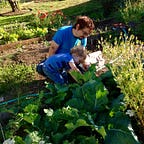Wild edibles: Fireweed is Everywhere
An awesome dry season wild edible
--
When people think of the Pacific Northwest, they generally think of wet, overcast, rainy weather. This is true for much of the year, but between June and October, our climate actually tends towards dry, drought-like conditions. This spring and summer have been particularly dry and hot (according to the local weather guru, Cliff Mass, this likely has little to do with climate change, but is still an indication of times to come).
We’re smack-dab in the middle of fire season, and since it’s been so warm and dry, we’re surrounded by wildfires on all sides. The smoke makes for some lovely sunsets:
Wildfire season also brings out the local Epilobium species. On a drive this weekend to a campsite, the fields and roadsides were coated in enormous stands of Epilobium angustifolium:
This guy loves dry conditions. It’s called “fireweed” because after a forest fire, it’s usually one of the first plants to sprout in burned areas. It’s also an incredibly useful and quite tasty wild edible!
You can use pretty much every part of this plant. The shoots can be cooked like asparagus. The flowers and young leaves can be eaten raw; they’re slightly sweet, and very mildly astringent. The stems, when older and thick, can be peeled and enjoyed as a snack. The older leaves can be cooked as a ‘potherb,’ as can the flowers, and act both to flavor and to thicken soups/stews/etc.
We found a nice stand of fireweed growing in a shady spot between the beach and a conifer forest area. I collected about a pound of flowers and leaves:
That evening, I made some camp chili: a couple of cans of beans, a can of diced tomatoes, some veggie chorizo, a couple of cloves of garlic, salt, pepper, and two handfuls of chopped up fireweed leaves and flowers/flower buds. The leaves added a piquant, feral flavor to the chili, and the flowers gave it a muted sweetness, and helped thicken the mixture as it cooked. DEE-LICIOUS!
Even in hot, dry, drought-like conditions, there is food everywhere you look.
If you live in the PNW, you may be more familiar with the Epilobium than you realize. One of the most common container “weeds” in our area is Epilobium ciliatum, Northern or Purple-leaved willow-herb. Here’s a whole page on how to “control” it:
Another option, which I (of course) condone: let it grow. It has pretty scarlet foliage and cute little pollinator-friendly pink leaves, and is also pretty much entirely edible, if a little blander than its fireweedy cousins. Still, the leaves can be added to stews and soups, or munched raw if you’re so inclined.
UPDATE: I was asked for a reference for my claim that Epilobium ciliatum is edible. Although I don’t have a book reference, and learned about this particular plant in a classroom setting, here’s a slideshow put out by “Friends of Madrona Marsh” with a couple of nice recipes and more information.
As it happens, most plants in the Epilobium genus are edible, but some are more edible than others, as the saying goes.
REQUISITE POISONOUS LOOK-ALIKE WARNING: When you’re driving down the road or hiking a prairie and you see a tall plant with pink/purple flowers, be sure it’s not foxglove (Digitalis purpurea), which can be fatal even in small doses. Don’t eat anything you’re not 100% sure of!
